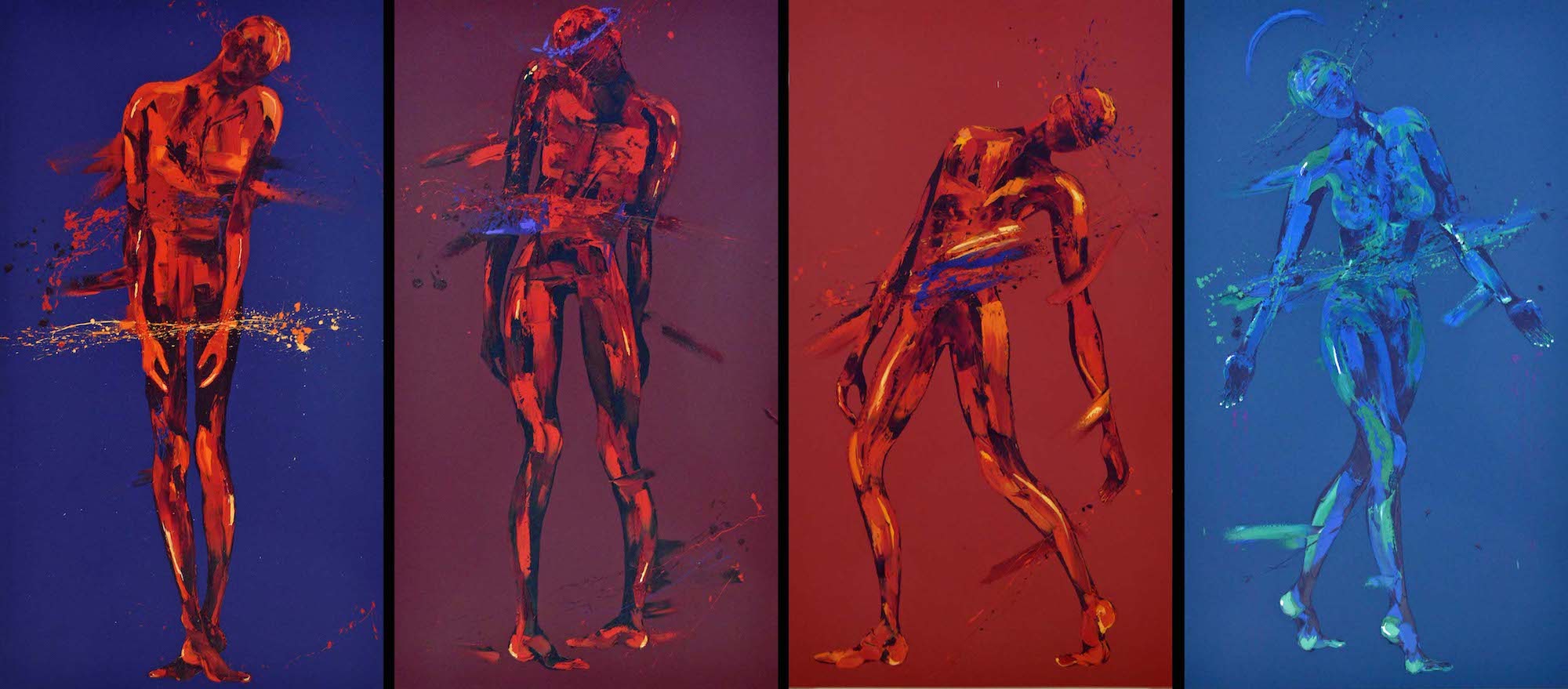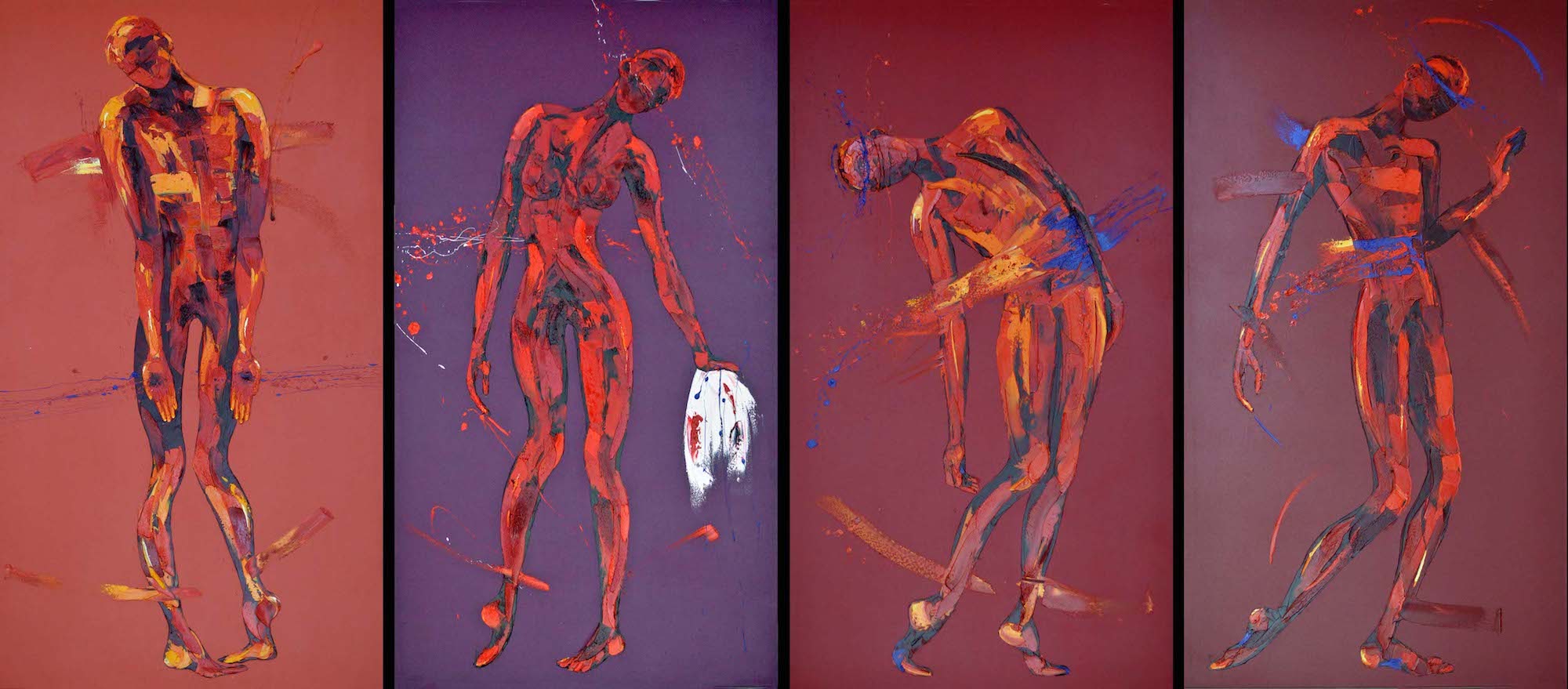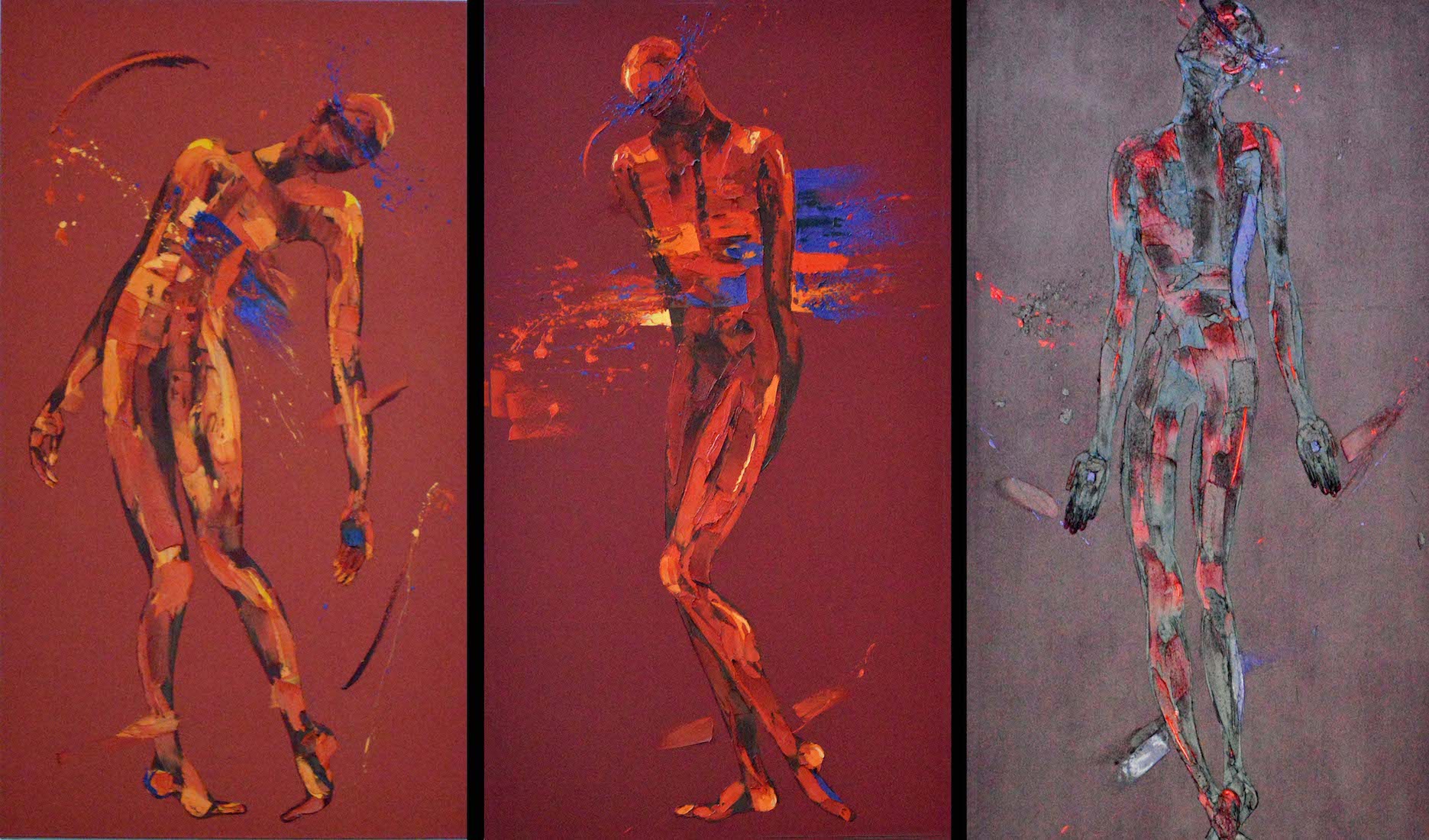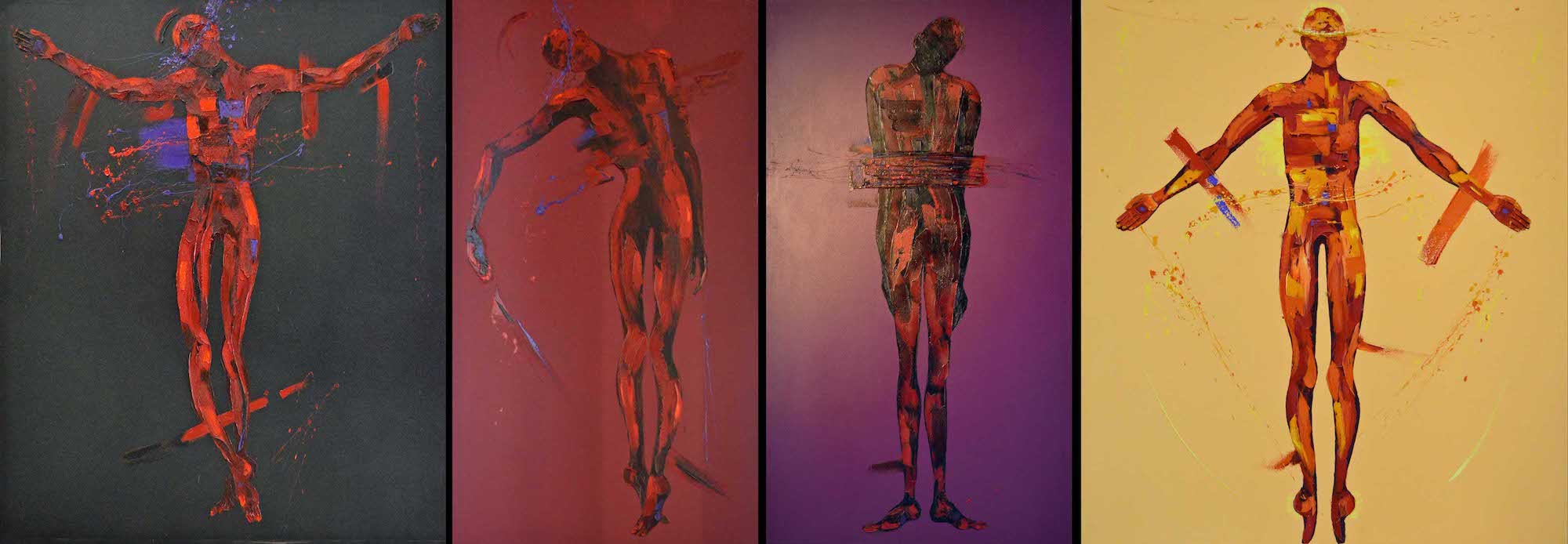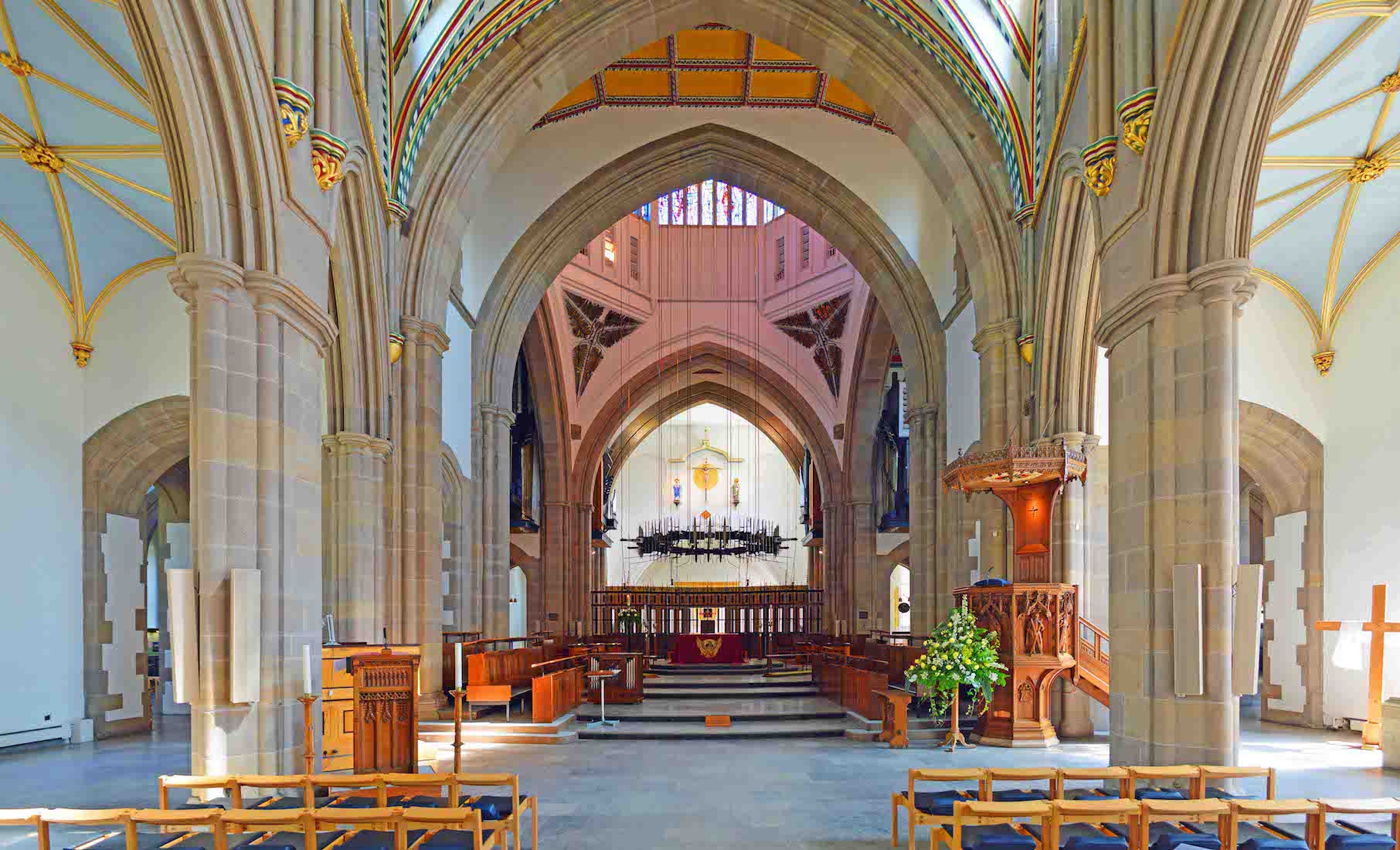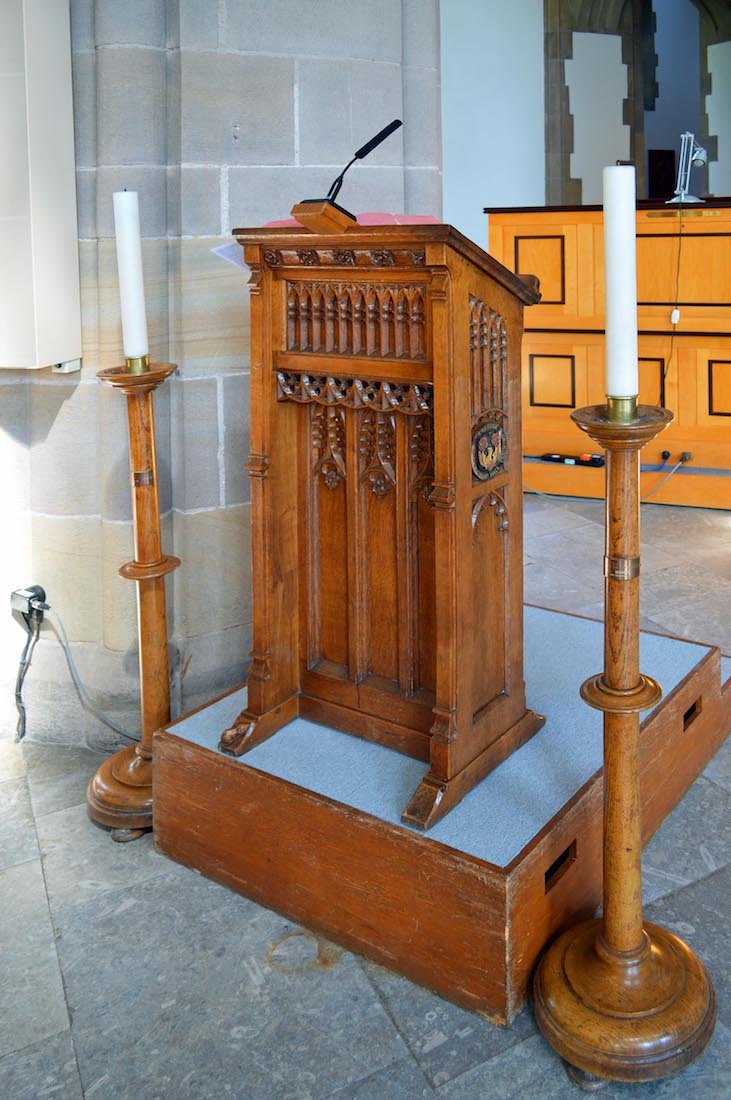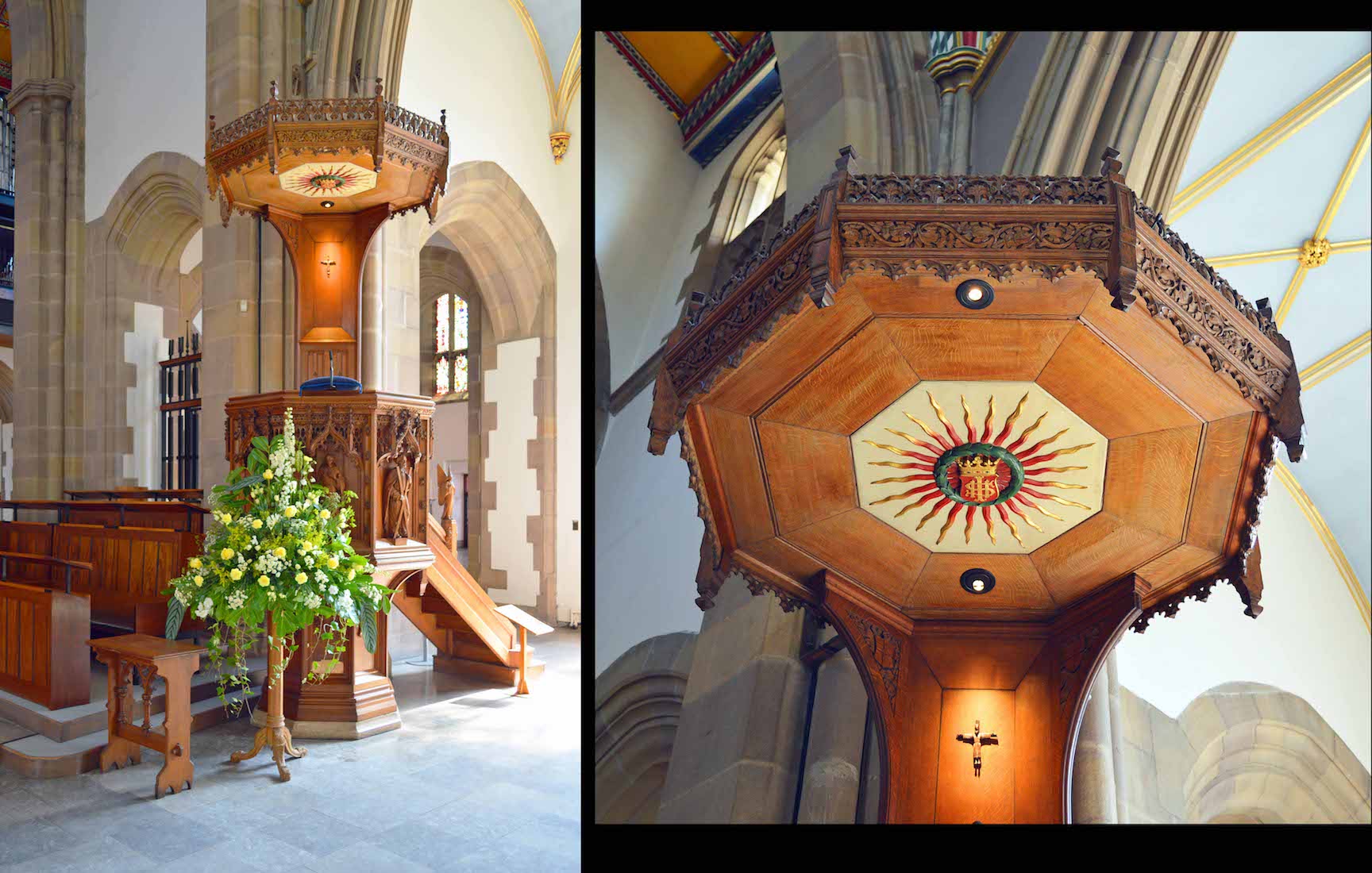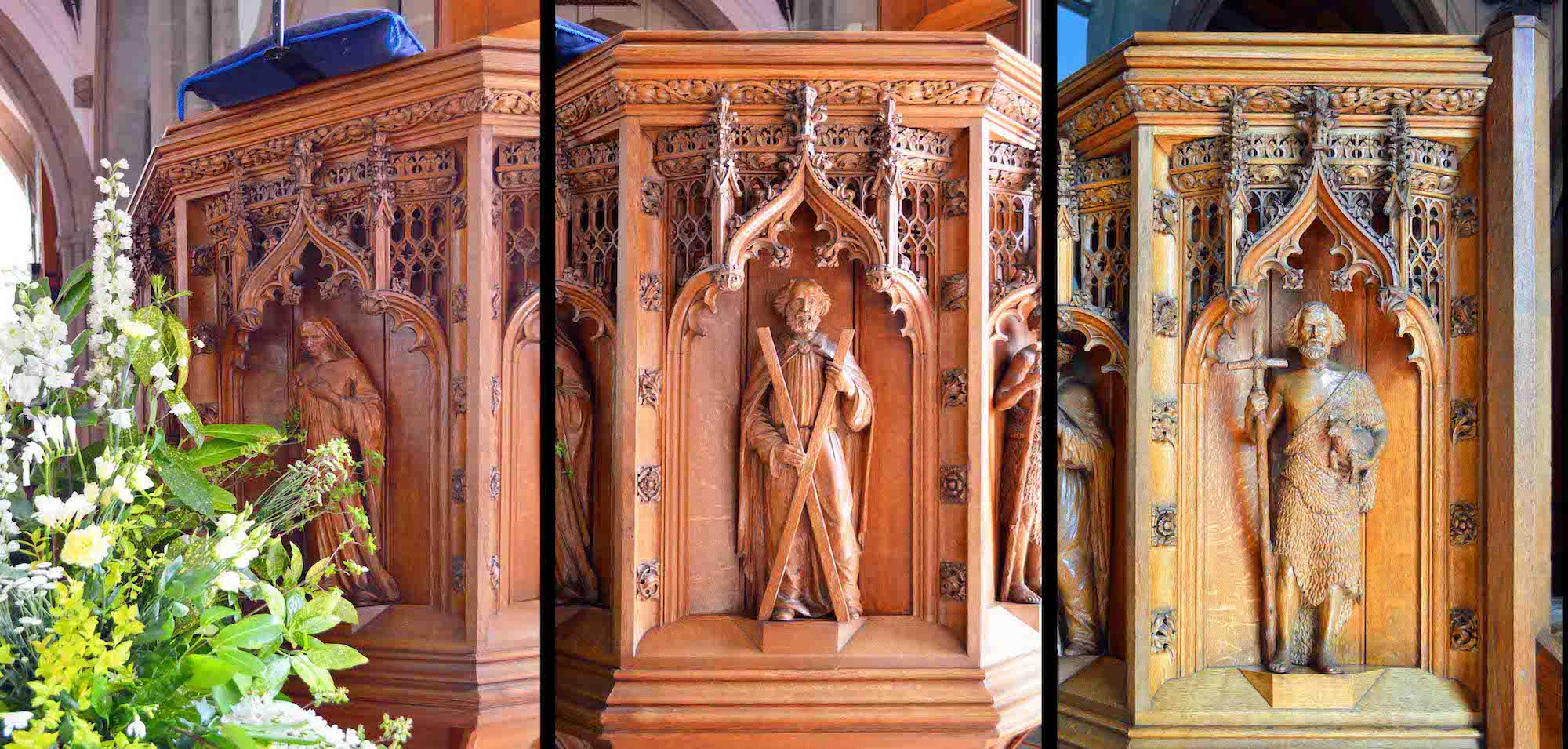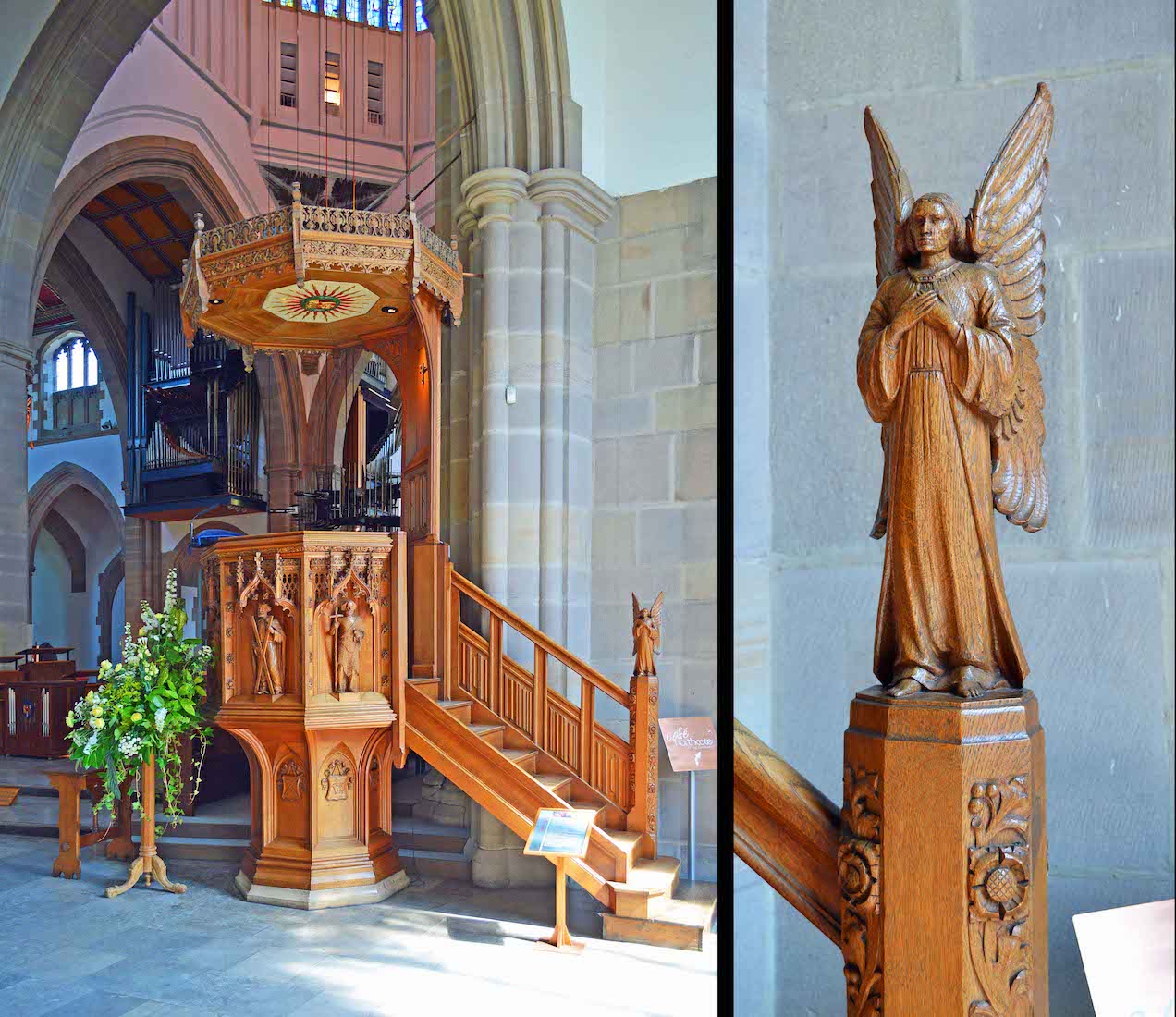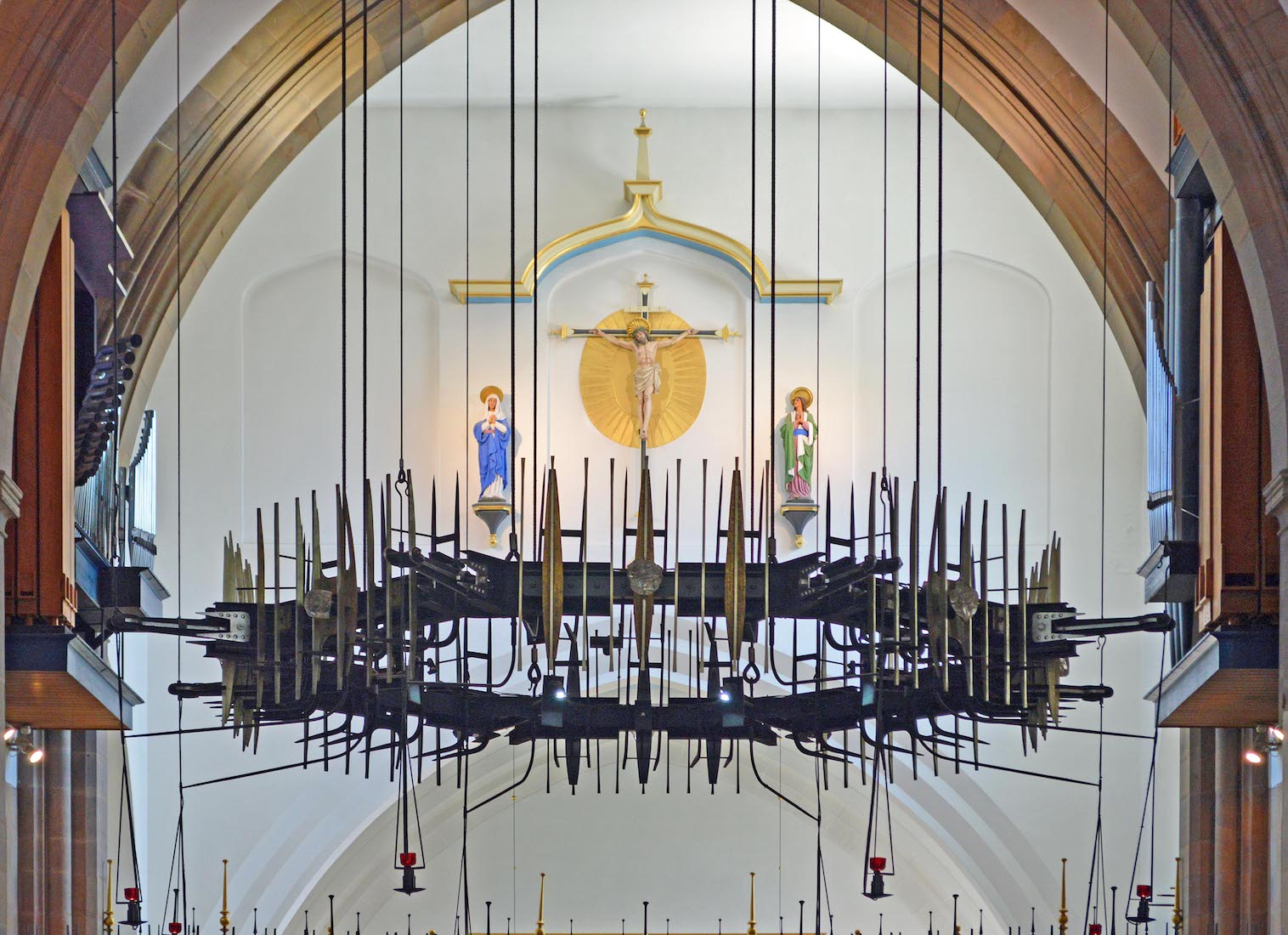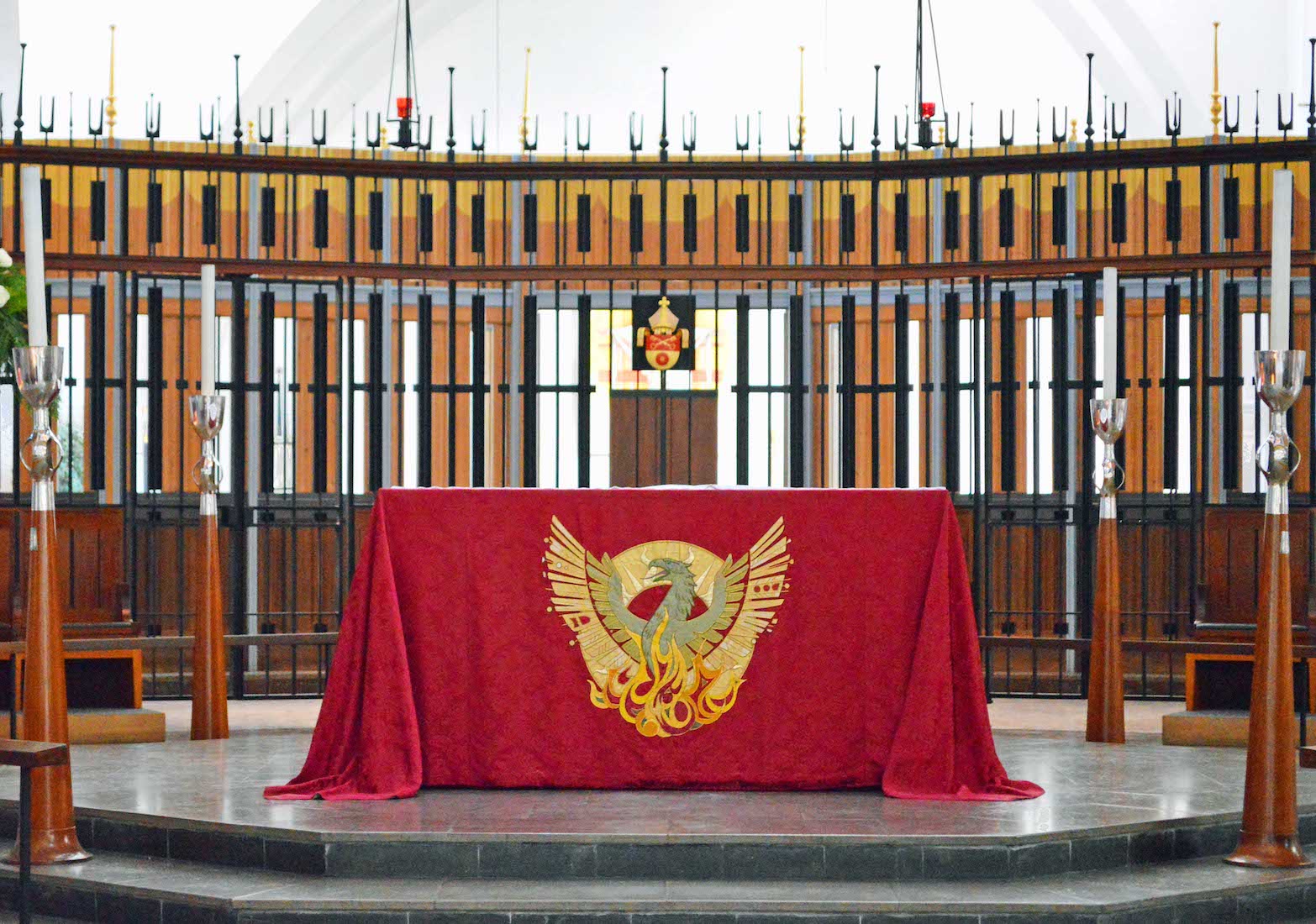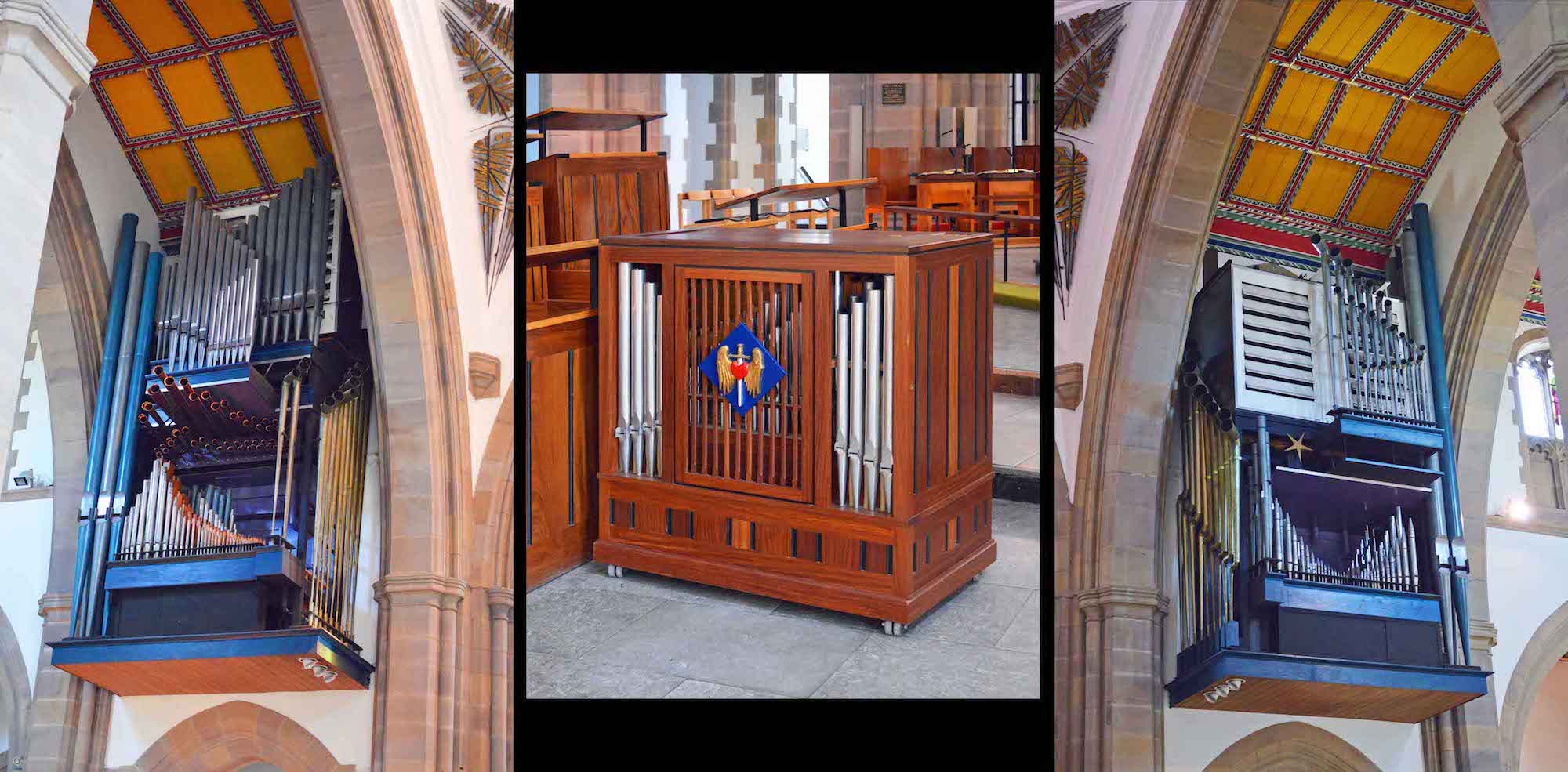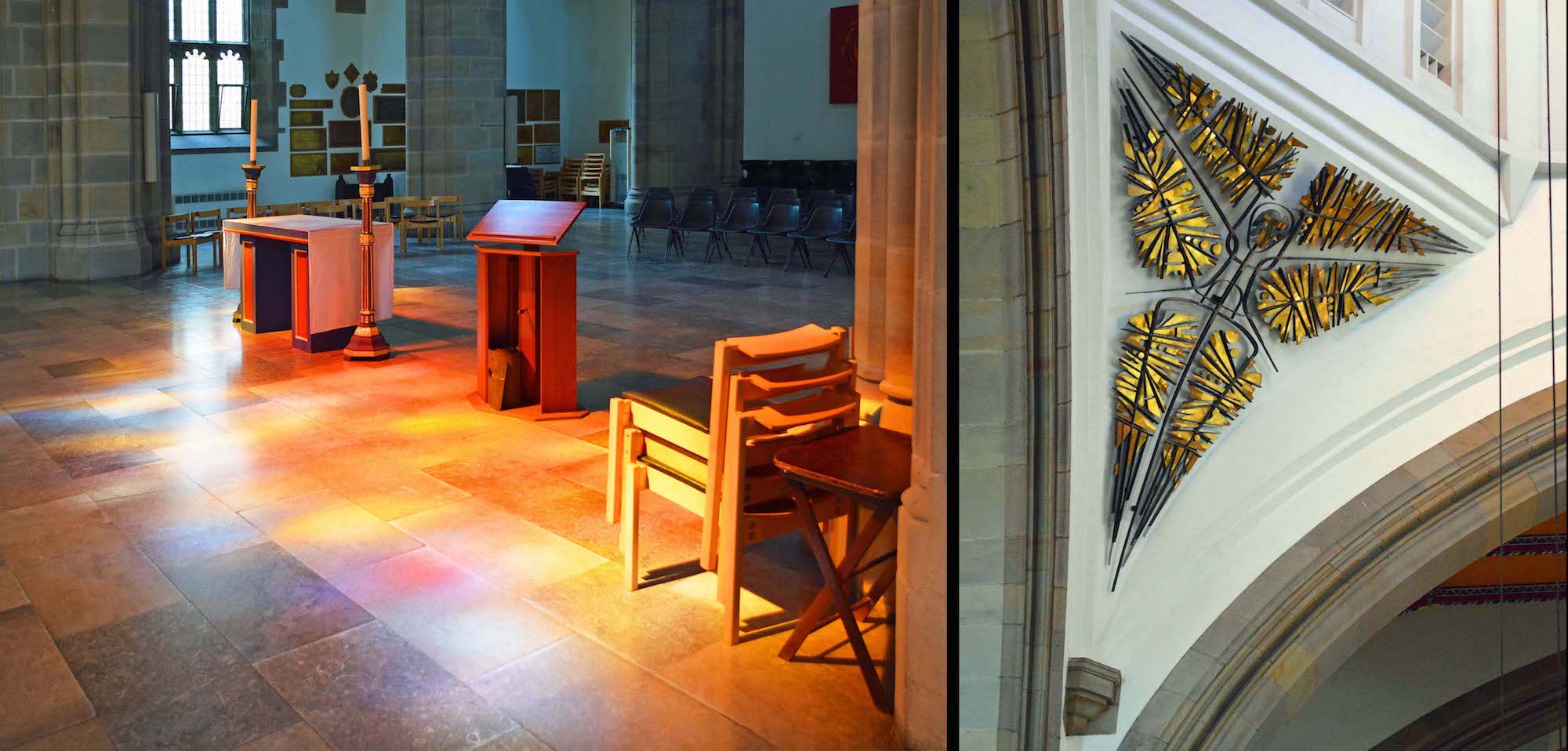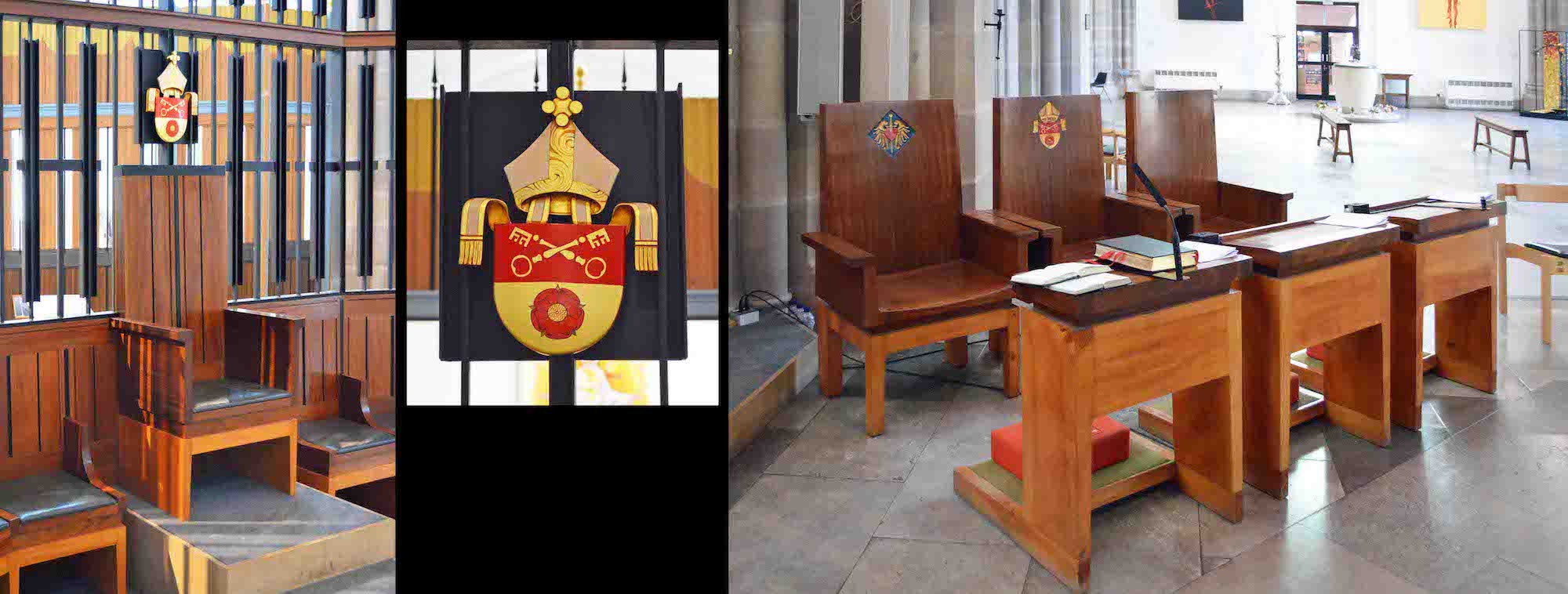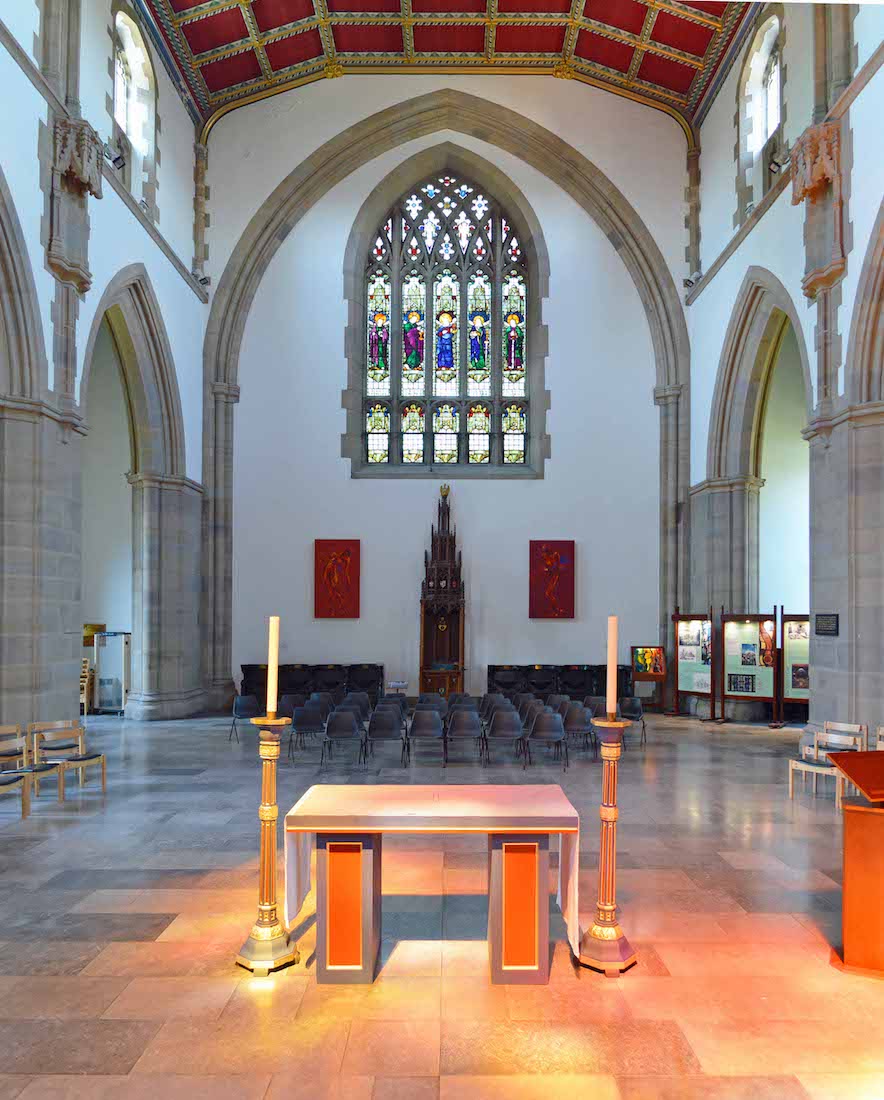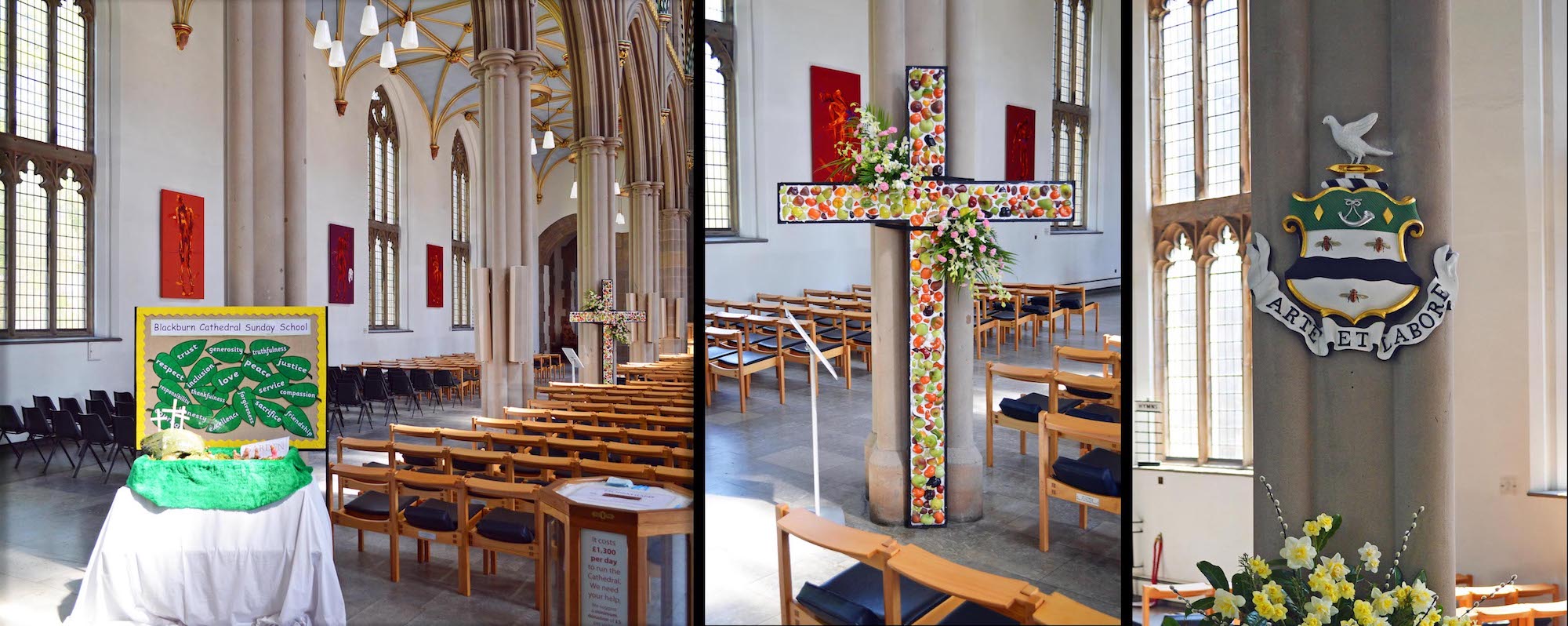
There are three items by various columns in the nave. At the rear of the nave is a small Easter Garden display, assembled by the Cathedral Sunday School. The view at left shows that further forward on this side is an unusual cross in whch pieces of (presumably artificial!) fruit are embedded. This brings to mind verses relating to the fruit of the Spirit, and the command to be fruitful and multiply. On the column across from this is the coat of arms of Blackburn Town, bearing the words ‘Arte et Labore’, meaning ‘By Skill and Hard Work’. PLAN
22. SIDE AISLES
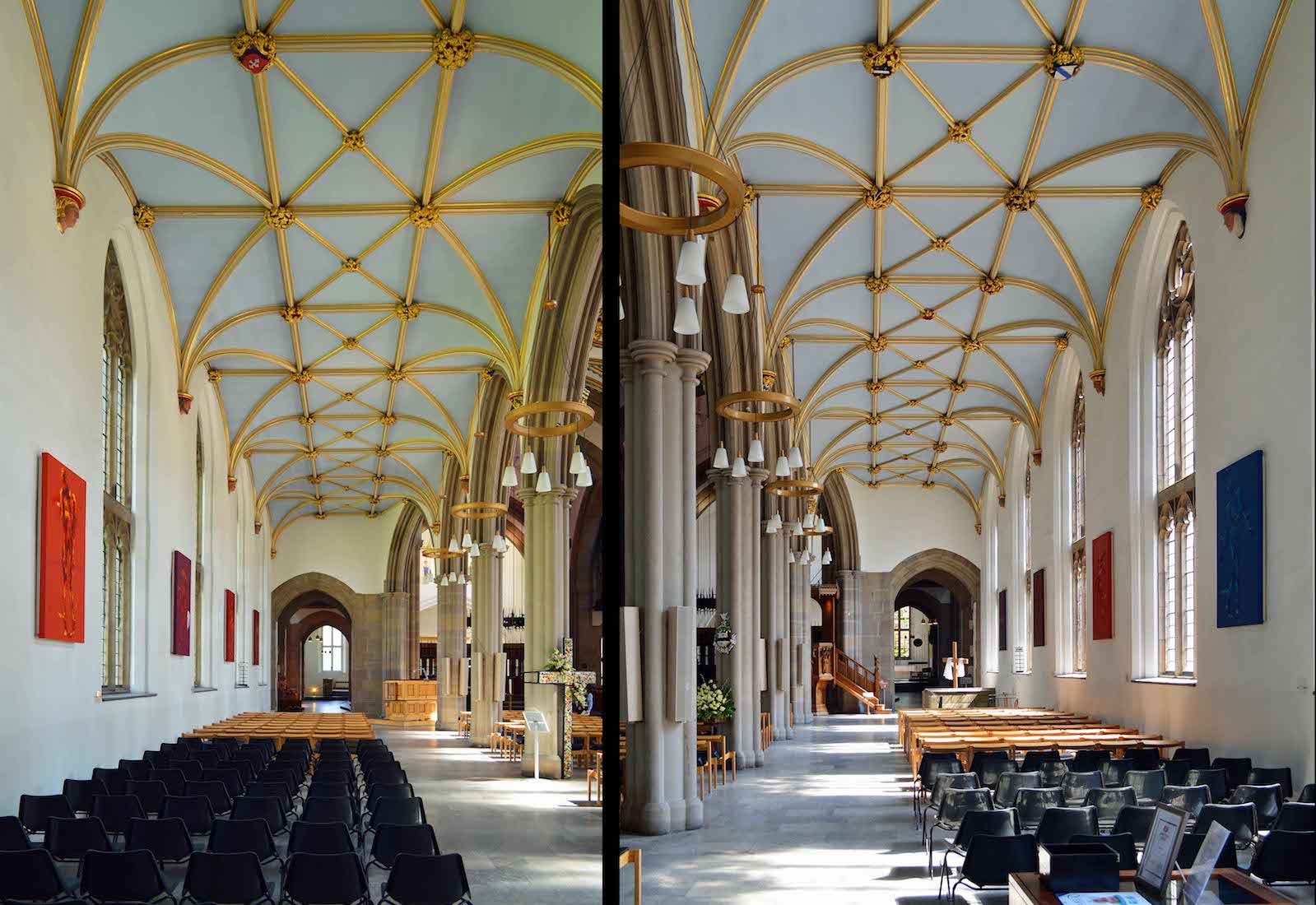
The side aisles of the nave are relatively unadorned. We notice the golden bosses and ceiling decorations, the plain side windows, and the painted artwork between the windows. We shall see that these are part of an artistic interpretation of the Stations of the Cross. To investigate this, we temporarily forsake our ‘walk around the Cathedral’.
23. ‘THE JOURNEY’ BEGINS ...
Lining the walls of the nave and transepts are a contemporary set of Stations of the Cross called ‘The Journey’ consisting of fifteen 6ft oil paintings depicting the final Journey of Christ to his death and resurrection. The paintings were commissioned in 2005 and are on permanent display in the Cathedral. The first four are on the South wall of the nave. They depict, from left: Jesus is condemned, Jesus is given his Cross, Jesus falls for the first time, Jesus meets his mother.
24. ‘THE JOURNEY’ CONTINUES ...
The next four paintings are on the North wall of the nave. They show, from left: Simon helps to carry the Cross, Veronica wipes the face of Jesus, Jesus falls for the second time, Jesus speaks to the women. The paintings are designed to form a ‘walking route’ to follow the way of the cross with Christ on his final journey. Artist Penny Warden says of her painting: ‘I don’t take long: I am an action painter. My paintings cannot be fully planned beforehand, because the process of painting them involves risks and accidents. I think painting is a pattern of one’s nervous system being projected on to canvas.’
25. ‘THE JOURNEY’ CONTINUES ...
These three paintings are found in the North transept. From left we have: Jesus falls for the third time, Jesus is stripped, Jesus is nailed to the Cross. Penny Warden: The result of this process is that the final image — which is my visual expression of the passion, pain, or energy within that figure — takes on its own life and independence.
26. ‘THE JOURNEY’ CONCLUDES
The final paintings in the series are in the South transept. We see here, from left: The Crucifixion, Jesus is taken down from the Cross, Jesus is placed in the tomb, the Resurrection. The then Dean of Blackburn, the Very Rev Christopher Armstrong said: ‘The Stations will be of national significance and complement the already impressive stock of modern art at the Cathedral. They will assist the Cathedral in its missionary mandate to tell the story of Christ’s last few hours to a puzzled and agnostic generation. These ‘Stations’ will engage with people where they are, in all the conflicts and sorrows which life brings in the 21st century.’
27. THE CROSSING
We have now investigated the Cathedral nave, and next come to the crossing. At centre we catch a glimpse of the lantern glass above, and the hanging crown of thorns. Beneath this is the nave altar with the bishop’s cathedra behind. In the left foreground stands a lectern with the organ console behind, and at right the pulpit. At extreme right stands a temporary draped Cross which probably appeared at Easter.
28. LECTERN
The lectern is nicely carved and on the side is a reference to Washington Hall Training College. This College was located in Chorley, 10 miles from Blackburn, and is now used for training firefighters. The lectern is used in services for the reading of the Scriptures. In this view we can see the back of the organ console in the background.
29. ORGAN CONSOLE
Blackburn Cathedral has a world-class four-manual organ, built by JW Walker and rebuilt by Wood of Huddersfield. This is not only showcased to great effect through its use as an inspirational liturgical instrument, but also through the many recordings that have been made and in the regular lunchtime concerts and organ meditations that take place throughout the year. Details of the organ specifications can be found at https://www.blackburncathedral.com/wp-content/uploads/2016/05/Blackburn-Cathedral-Organ-Specification.pdf .
30. PULPIT
The pulpit dates from 1940 and is a memorial to local physician Dr James T.T. Ramsay. It is a particularly fine example of Gothic Revival work, and around it are carved representations of the first followers of Jesus: Peter, James, John, the Virgin Mary, Andrew, and John the Baptist. On the tester (canopy) above the pulpit is painted the Greek monogram showing the first three letters of the name Jesus. Behind the preacher is a replica of the famous ‘Christus’ (crucifix) in Braunschweig Cathedral in Germany, to which Blackburn Cathedral has been linked since the 1990s..
31. PULPIT DETAIL
Here we see close up views of (from left) the Virgin Mary, Andrew carrying his diagonal cross, and John the Baptist.
32. PULPIT: ACCESS AND ANGEL
This view of the pulpit shows the stairs, with yet another angel at the end of the rail. This pulpit was one of the first gifts of ‘new’ furniture to mark the transition of Blackburn Parish Church to Blackburn Cathedral. The pulpit is used each week to proclaim the Word of God.
33. CROWN OF THORNS
The Crown of Thorns or Corona by artist John Hayward emphasises the costly pain of the Cross, but is also encrusted with large jewels (crystals). So on the one hand Jesus on the Cross went to a place of abandonment and loss, of suffering and pain. This lies at the heart of the Christian gospel. But on the other hand, the Cross is also the place of hope and new possibilities, pointing to the throne from which Christ, the King of all the world, reigns in glory. On the wall behind hangs a rood cross by woodcarver Advent Hunstone, with Mary on the left and disciple John on the right.
34. NAVE ALTAR
The nave altar sits in the middle of the crossing, directly beneath the lantern tower. This is the focus of a Christian service, with the Elements of the Eucharist being distributed from here. The altar cloth depicts the legendary phoenix rising from the ashes – a symbol of the Resurrection of Christ for early Christians.
35. ORGANS
Up by the arches leading to the transepts are the pipes for the main cathedral organ. There is also another small chamber organ placed near the altar. This is a four stop chamber organ built in 2001 by Kenneth Tickell.
36. THE LANTERN
The octagonal lantern tower was designed by architect Laurence King. There are seven panes of glass on each face, giving a total of 56 panes of coloured glass. The tower was completed in 1967, but structural problems caused it to be rebuilt to a design by Brian Lowe between 1998 and 1999. The central boss - the dove, symboling the Holy Spirit - was preserved, but John Hayward’s glass was replaced with Linda Walton’s abstract blues, oranges, reds and yellows. Linda’s glass depicts the water of baptism and the tongues of flame which descended on the heads of the disciples at the first Pentecost.
37. CROSSING LIGHTS AND SERAPHIM
A delightful effect of the coloured lantern glass is that the crossing changes mood almost moment by moment. Four six-winged seraphim have been placed at the intersections of the supporting arches of the lantern. These were designed by John Hayward. Medieval Christian theology places seraphim in the highest choir of the angelic hierarchy. They are the caretakers of God’s throne, continuously singing ‘holy, holy, holy’.
38. CATHEDRA AND STALLS
Immediately behind the nave altar stands the cathedra – the seat of the bishop of the Blackburn Diocese. On its back it bears the crest of Blackburn Diocese. Every cathedral has its own cathedra – this is where the name comes from. On either side of the altar is a set of three stalls, which are occupied by those officiating during services.
39. NORTH TRANSEPT
We look next to the North transept. Most obvious are the stained glass window and the interesting roof treatment. Below the window is what looks like another cathedra, and old choir stalls on either side. Two of Penny Ward’s paintings can be seen on the far wall. At right are some display panels, and a wall plaque. For future reference there is the glimpse of a brass plaque at extreme left too. The high clerestory windows are of clear glass.
40. NORTH TRANSEPT CEILING
The roof here is colourful and patterned in squares. The supporting ribs have detailed painted decoration. The ceiling of the South transept has been given the same treatment.


